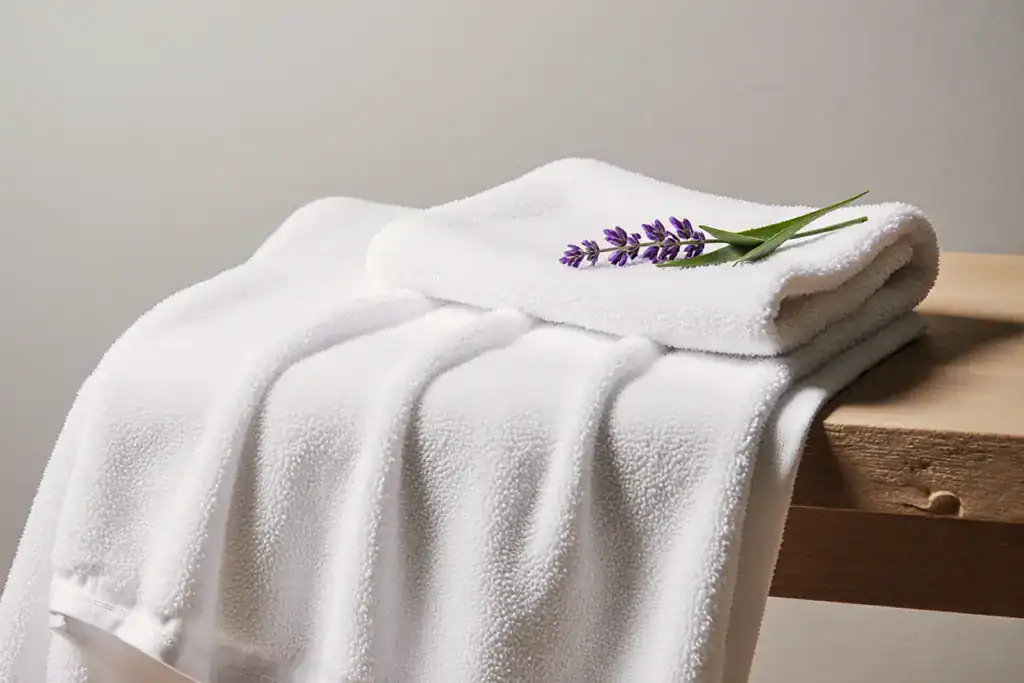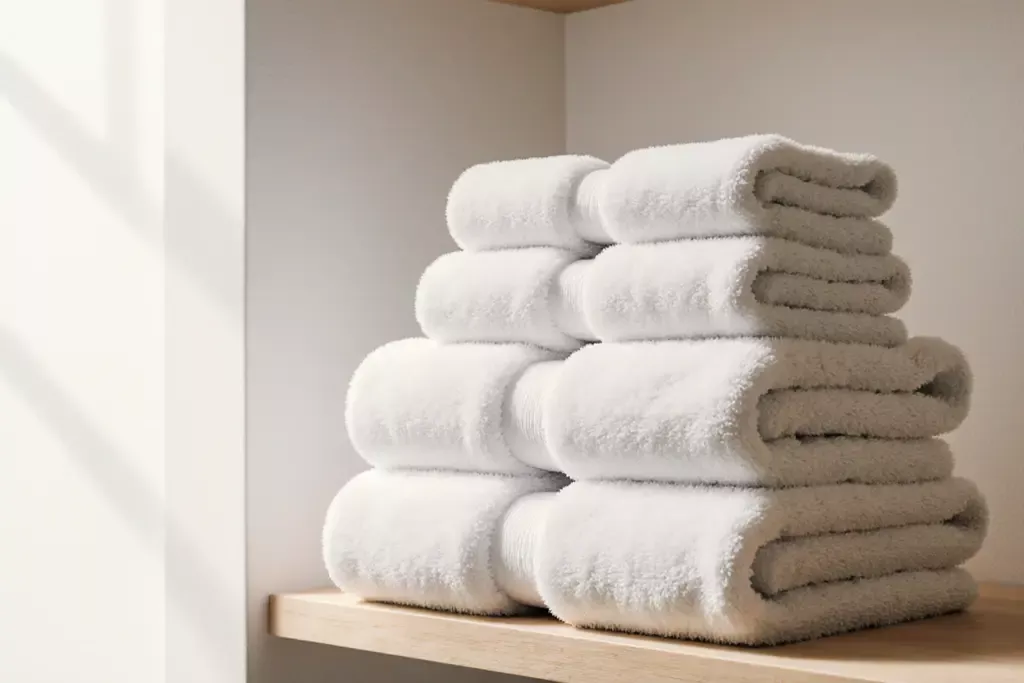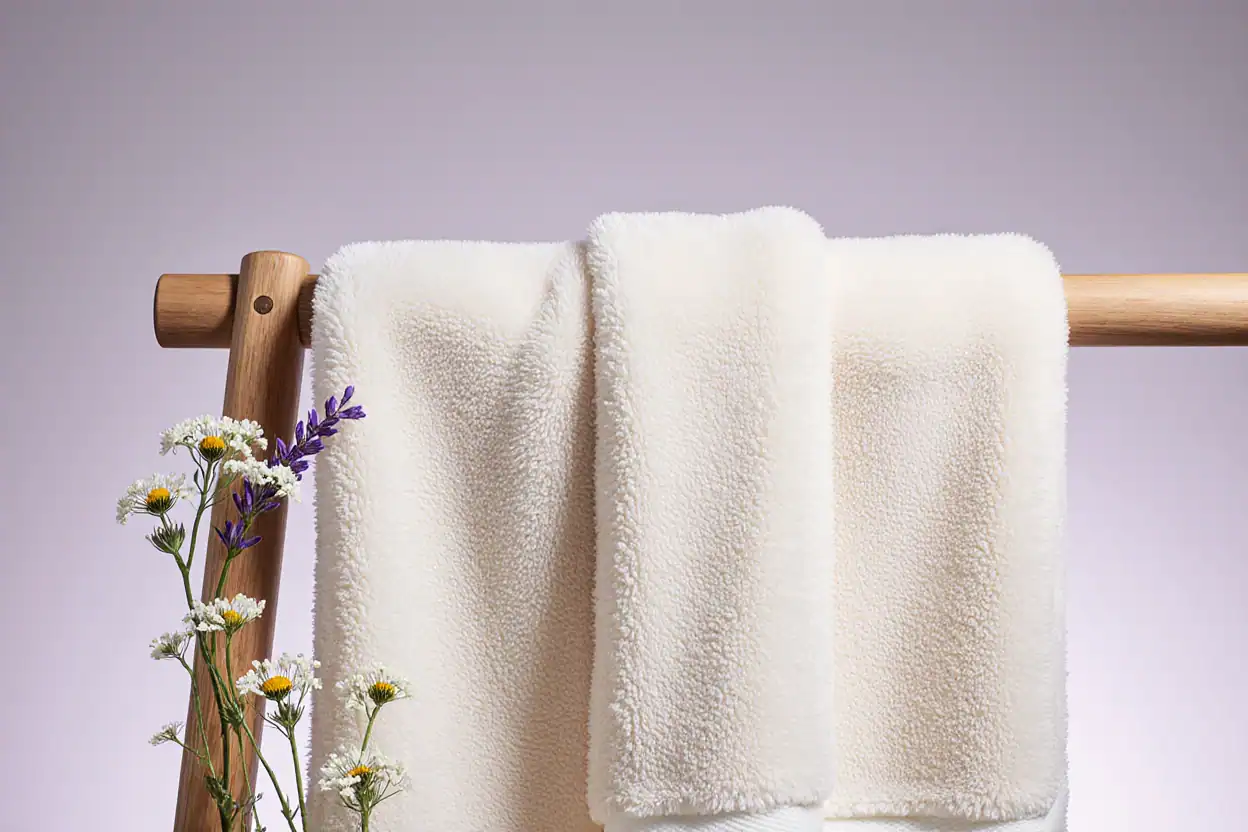Sensitive skin thrives on gentle fabrics, low‑irritant products, and clean, dry towels with no lingering residues. Poor towel care can introduce everyday triggers—fragrance, dyes, leftover detergent, fabric softeners, and mildew—that lead to redness, itching, and flare‑ups. This comprehensive guide explains towel maintenance for sensitive skin step by step, including which towels to buy, how to wash and dry them safely, how to prevent residues and odors, and what to do if irritation persists—so towels stay soft, hygienic, and skin‑safe for everyone at home, including young children and those prone to eczema or contact dermatitis.
Key Takeaways
- Choose hypoallergenic, fragrance‑free detergents; fragrances and certain chemicals often trigger contact dermatitis and irritation.
- Avoid liquid fabric softeners with perfumes and quats; they commonly irritate sensitive or eczema‑prone skin.
- Wash towels warm to hot if fabric allows, and add an extra rinse to reduce detergent residue—the frequent culprit behind itching and rashes.
- Keep towels fully dry between uses; airflow or sunlight helps deter mildew and odor that can aggravate skin.
- For musty or filmy towels, refresh with white vinegar and baking soda to break down buildup and restore softness without harsh chemicals.
Why Towel Maintenance Matters for Sensitive Skin
Sensitive skin’s barrier is easy to disrupt, and towels are in constant contact with that barrier. Two issues cause most problems:
- Fiber friction and fabric feel: Rough or scratchy fibers increase mechanical irritation; smoother loops reduce friction against reactive skin.
- Chemical residues and microbes: Fragrances, dyes, preservatives, and quats from softeners can linger on fabric, while residual detergents, mildew, and bacteria can trigger or worsen dermatitis and eczema.
Common irritants to watch:
- Heavily fragranced detergents and softeners that leave residue on fibers.
- Residual soap/detergent from overdosing or insufficient rinsing.
- Mildew and bacteria from towels that stay damp or poorly ventilated.
- Enzymes or brighteners if not tolerated by the user; opt for well‑tolerated, fragrance‑free formulas tested for sensitive skin.
Best Practices for Sensitive Skin‑Friendly Towel Care

Choosing the Right Towels
- Soft, low‑friction fibers: Choose 100% cotton (combed or ring‑spun), bamboo‑viscose, or soft microfiber with smooth loops to reduce abrasion.
- Hypoallergenic and dye‑free: Minimize unnecessary fabric treatments; light or undyed options are often gentler.
- Separate face and body towels: The face is more reactive; use smaller, soft face towels changed more frequently.
Washing Techniques
- Detergent: Use fragrance‑free, dye‑free, hypoallergenic “free & clear” detergents.
- Dose properly + extra rinse: Overdosing leaves residue; use the recommended amount and add an extra rinse to clear surfactants—especially helpful in hard water.
- Temperature: Warm to hot when fabric allows helps dissolve detergents and oils more completely and assists with odor‑causing buildup.
- Skip liquid softeners: Many contain fragrances and quats linked to irritation; use alternatives if needed.
- Gentle refresh: White vinegar in the rinse can help remove residues; baking soda boosts freshness and helps break buildup.
Suggested approach:
- Start with a reputable fragrance‑free liquid detergent.
- Use half to three‑quarters of the dose if loads are small or lightly soiled; add an extra rinse.
- If towels feel slimy or stiff, run a vinegar rinse and cut back detergent next time.
Drying Tips
- Dry completely: Damp towels harbor bacteria and mildew that can irritate skin.
- Airflow first: Line‑dry or air‑dry in ventilated areas; sunlight naturally deodorizes.
- Moderate heat: Avoid excessive dryer heat that can stiffen fibers; combine air‑drying and gentle tumble for softness.
Storage Practices
- Store only when fully dry to prevent mustiness.
- Ventilated storage: Open shelves or breathable baskets instead of tightly packed stacks.
- Rotate: Keep a healthy rotation so no towel is repeatedly used while still damp.
Step‑by‑Step Maintenance Routine

Daily
- After use, shake and hang towels fully open on a bar or wide hook in a ventilated space; avoid bunched or folded‑over drying.
- Use separate face towels; swap face towels daily or every other day for acne‑prone or very sensitive skin.
Weekly
- Wash body towels every 3–4 uses with a fragrance‑free detergent; add an extra rinse to reduce residue.
- Skip fabric softener; if extra softness is needed, add 1 cup white vinegar to the rinse instead.
- Ensure complete drying—airflow or gentle tumble until fully dry.
Monthly (or as needed)
- Refresh routine: One wash with 1 cup white vinegar (no detergent), then a second wash with 1/2 cup baking soda to strip buildup and odors.
- Inspect storage areas for humidity; improve ventilation if towels smell stale soon after storage.
Quick Reference Table
| Step | Action | Benefit |
|---|---|---|
| Daily | Hang fully open in airflow; separate face towels | Less moisture and bacteria; reduced facial irritation |
| Weekly | Wash with fragrance‑free detergent; extra rinse | Fewer residues that trigger itching and rashes |
| Weekly | Skip liquid softener; use vinegar in rinse | Minimizes irritants; reduces buildup and stiffness |
| Weekly | Dry fully; avoid damp storage | Prevents mildew and odor that aggravate skin |
| Monthly | Vinegar + baking soda refresh cycles | Strips residues; restores softness and freshness |
Pro Tips & Expert Tricks
- Go “free & clear”: If irritation appears, switch entirely to fragrance‑free, dye‑free detergents for 2–3 weeks and monitor skin.
- Extra rinse as default: Towels touch the most skin—use an extra rinse on every towel load.
- Vinegar in the rinse: Use 1 cup white vinegar in the softener dispenser; it helps dissolve detergent film and leaves towels more skin‑friendly without perfumes.
- Baking soda boost: Add 1/2 cup to occasional washes to neutralize odors and reduce buildup—ideal for musty towels without harsh additives.
- Gentle fibers last longer: Softer fabrics reduce friction; replacing rough, worn towels often improves comfort immediately.
- Be cautious with “scent boosters”: Even “lightly scented” products can cause flares; avoid for sensitive users.
Dealing with Towels That Cause Irritation
Signs of trouble:
- Itching or redness after drying off, especially right after laundry day—often a residue issue.
- Musty odor even after washing—usually microbial buildup or detergent film trapping odor.
- Towels feel stiff, slick, or coated—detergent overdose or softener residue.
Safe restoration steps:
1) Deep refresh: Run a warm/hot wash with 1 cup white vinegar (no detergent). Follow with a second warm wash using 1/2 cup baking soda. Dry completely.
2) Adjust routine: Reduce detergent dose, add an extra rinse, and avoid liquid softeners; keep loads smaller for better rinsing.
3) Product swap: Try another fragrance‑free, hypoallergenic detergent.
4) Improve drying: Air‑dry with space or line‑dry in sunlight; ensure towels are fully dry before storage to prevent mildew.
If irritation persists, eliminate potential triggers one by one (softener, scented boosters, optical brighteners) and consult a dermatologist, especially for eczema‑prone households.
Real‑Life Examples
- The “freshly washed itch”: A parent noticed a child’s back itching after bath time only on laundry day. Swapping to a fragrance‑free detergent, halving the dose, adding an extra rinse, and using a vinegar rinse resolved irritation within a week.
- The musty towel loop: In a humid apartment, towels smelled “clean‑but‑musty.” Switching to hang‑drying fully open, occasional sun‑drying, and a monthly vinegar + baking soda refresh eliminated odor and stopped post‑shower redness.
- The softener surprise: A household relying on heavily fragranced softener had facial breakouts and neck itch after showers. Removing softener and moving to a free‑and‑clear detergent eliminated flares in days.
FAQs
- How often should I wash towels for sensitive skin?
Wash body towels every 3–4 uses with a fragrance‑free detergent, and change face towels daily or every other day if acne‑prone or very reactive; always add an extra rinse. - Are fabric softeners safe for sensitive skin?
Conventional fragranced softeners commonly contain quats and perfumes that can provoke irritation and eczema flares; most sensitive‑skin routines skip them or use verified hypoallergenic, fragrance‑free alternatives sparingly. - Can mildew or detergent residue cause rashes?
Yes—mildew and bacterial buildup can aggravate sensitive skin, and detergent residue is a frequent trigger for itching and contact dermatitis; focus on proper dosing, thorough rinsing, full drying, and periodic vinegar/baking soda refreshes. - Which detergent should I choose?
Look for “free & clear,” dermatologist‑tested, fragrance‑free formulas; liquids often rinse cleaner than powders for some users. Patch‑test changes and monitor skin responses. - Do vinegar and baking soda really help?
White vinegar helps dissolve soap/detergent films, and baking soda boosts freshness and reduces buildup—together they’re widely used to restore softness without harsh chemicals.
Conclusion
Towel maintenance for sensitive skin is about friction control, residue control, and moisture control. Choose gentle fibers, wash with fragrance‑free detergent using proper dosing and an extra rinse, skip conventional softeners, refresh periodically with vinegar and baking soda, and dry towels completely with good airflow. These simple, consistent habits reduce common triggers—fragrance, quats, leftover surfactants, and mildew—so towels stay soft, clean, and skin‑safe for sensitive users, babies, and anyone prone to irritation.

